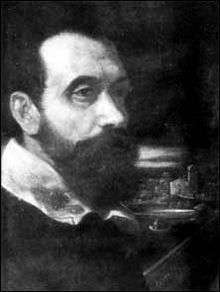Giovanni Faber
| Giovanni Faber | |
|---|---|
 Giovanni Faber | |
| Born |
1574 Bamberg |
| Died | 1629 |
| Nationality | German |
| Fields | botany, medicine, anatomy |
| Alma mater | University of Würzburg |
| Known for | Lincean, naming the microscope. |
|
Signature | |
Giovanni Faber (or Johann Faber) (1574–1629) was a German papal doctor, botanist and art collector, originally from Bamberg in Bavaria, who lived in Rome from 1598. He was curator of the Vatican botanical garden, a member and the secretary of the Accademia dei Lincei.[1] He acted throughout his career as a political broker between Maximilian I, Elector of Bavaria and Rome.[2] He was a friend of fellow Linceian Galileo Galilei, and the German painters in Rome, Johann Rottenhammer and Adam Elsheimer. He has also been credited with inventing the name "microscope".[3]
Biography
Johann Faber was born the son of Protestant parents in Bamberg in 1574. When he was one year old he was orphaned by an epidemic of the plague. He was raised and educated in the Catholic faith by his cousin Philip Schmidt. He studied medicine at the University of Würzburg and graduated in 1597. In order to deepen his studies he moved to Rome in 1598, where he worked as a doctor in the hospital of Santo Spirito in Sassia. His practical studies of anatomy proceeded from direct observation of the human body.[4] He later turned exclusively to the study of animal anatomy. In 1600 he was appointed to the chair of Botany and of Anatomy. In the same year he became the director of the Papal botanical garden, now the Orto Botanico dell'Università di Roma "La Sapienza". Thanks to these new engagements he attended the papal court more regularly. He also cultivated deep artistic interests, becoming an avid collector of paintings. In 1611 Faber's interest in natural investigation led him to become a member of the Accademia dei Lincei.
Naming the microscope
Giovanni Faber has been credited with giving the microscope its name. In 1609 fellow Lincean Galileo developed a compound microscope with a convex and a concave lens which he called the occhiolino, the "little eye". In 1624 Galileo presents his occhiolino to Prince Federico Cesi, founder of the Accademia dei Lincei. One year later Giovanni Faber coined the word microscope from the Greek words μικρόν (micron) meaning "small", and σκοπεῖν (skopein) meaning "to look at". The word was meant to be analogous with telescope, another word coined by the Linceans.[5][6]
Notes
- ↑ chnm.gmu.edu Carlo Ginzburg - Clues: Morelli, Freud,and Sherlock Holmes - God is hidden in details. -G. Flaubert and A. Warburg
- ↑ "Medical competence, anatomy and the polity in seventeenth-century" by Rome Silvia De Renzi, Renaissance Studies Vol. 21 No. 4
- ↑ brunelleschi.imss.fi.it "Il microscopio di Galileo"
- ↑ Irene Baldriga, "Il museo anatomico di Giovanni Faber Linceo", in Scienza e miracoli nell'arte del '600. Alle origini della medicina moderna (Electa: Rome) 1998:82–87.
- ↑ Letter from Giovanni Faber to Prince Frederico Cesi dated April 13, 1625. An English translation of Faber's letter is available in: William B. Carpenter with W. H. Dallinger, ed., The Microscope and Its Revelations, 8th ed. (Philadelphia, Pennsylvania: P. Blakiston's Son & Co., 1901), pages 124-125.
- ↑ brunelleschi.imss.fi.it "Il microscopio di Galileo"
References
- "Medical competence, anatomy and the polity in seventeenth-century" by Rome Silvia De Renzi, Renaissance Studies Vol. 21 No. 4
- COMITATO NAZIONALE PER IL IV CENTENARIO DELLA FONDAZIONE DELLA ACCADEMIA DEI LINCEI - Faber Schmidt